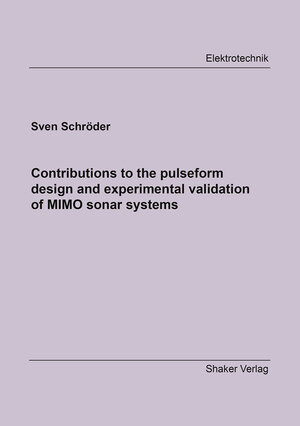
×
![Buchcover ISBN 9783819101298]()
Contributions to the pulseform design and experimental validation of MIMO sonar systems
von Sven SchröderActive sonar systems are used in a variety of underwater applications to locate objects and for imaging. Conventional active sonar systems have a single transmitter to emit an acoustic signal. The signal scattered back from objects is received by multiple receivers usually arranged in an array. The obtained travel time information can be used to determine the location of a backscatter. A Multiple-Input-Multiple-Output (MIMO) sonar is an extension of this principle, in which multiple transmitters with different transmitter signals are used. The design of the transmitter signals enables them to be separated in the receiving-side signal processing. This principle allows the travel time information to be multiplied by introducing additional transmitters, which can improve the angular resolution of the system. The pulseform design is essential to improve the separability of the transmitter signals and thus minimize crosstalk (cross-correlation noise) between signal paths. In this thesis, three pulseform designs are presented and optimized for the use in MIMO sonar systems. The optimization is based on the minimization of sidelobes in the Point-Spread-Function (PSF) of the system caused by crosstalk. Thereby, different cost functions based on the Generalized-Integrated-Sidelobe-Level (GISL) are compared.
Furthermore, experimental studies are carried out with a MIMO sonar system. It can be demonstrated that the angular resolution can be improved using the MIMO principle and that large virtual arrays can be created with less hardware than it would have been required in a conventional system. The investigations also show that pulse separation is decisive for the functionality of MIMO systems and that the optimal choice for this can vary depending on the application.
Furthermore, experimental studies are carried out with a MIMO sonar system. It can be demonstrated that the angular resolution can be improved using the MIMO principle and that large virtual arrays can be created with less hardware than it would have been required in a conventional system. The investigations also show that pulse separation is decisive for the functionality of MIMO systems and that the optimal choice for this can vary depending on the application.


